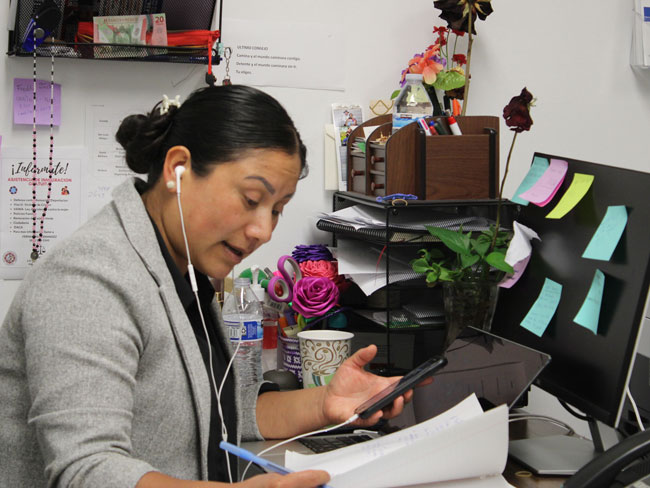Medicare telehealth flexibilities should be here to stay
We urge Congress to extend policies that have improved access to care and increased equity.
Medicare patients use computers and phones to have convenient appointments with doctors.
By Keavney Klein, Senior Counsel, Government Relations
The numbers seem unreal.
Medicare patients’ use of telehealth jumped 63-fold in 2020 compared to 2019.
During the COVID-19 pandemic, the federal government eased restrictions on telehealth for older adults in traditional Medicare. This helped more Medicare patients get care while staying safe at home.
High rates of telehealth use among all Medicare patients continued from 2021 to 2023. But the flexibilities allowing more Medicare participants to use telehealth expire at the end of 2024.
Now, lawmakers are asking important questions about the future of telehealth:
- Should these flexibilities be continued?
- Does telehealth replace in-person care?
- Does it lead to more in-person care (if the patient's issue wasn't resolved by the virtual visit)?
- Does it lead to higher costs?
At Kaiser Permanente, our experience and research provide answers.
Flexibilities we support
Before the pandemic, Medicare didn’t cover telehealth visits for most patients in traditional Medicare. This was because of an old policy that only covered telehealth visits for Medicare patients in rural areas of the country. And because Medicare only covered video visits (not visits by phone).
Kaiser Permanente’s Medicare Advantage plan has always had more flexibility to offer telehealth services to a wider array of Medicare participants. But the 50% of Medicare participants who have traditional Medicare were not as fortunate.
Recognizing the value of telehealth as a care delivery method, we were a leading voice in urging Congress to change that policy.
Then, the pandemic changed everything.
When the federal government declared COVID-19 a public health emergency, the U.S. Department of Health and Human Services had more authority. It could waive or relax many federal regulations to keep people safe and healthy.
HHS temporarily adopted new policies that we supported. For patients in traditional Medicare, HHS allowed Medicare to cover:
- Telehealth visits in any location (urban or rural, including at home)
- Telehealth visits with a wider variety of clinicians
- Phone and video appointments
The option for phone appointments has been especially helpful to patients who don’t have reliable internet access or struggle to use video technology. The change supported more equitable access to care.
These policies were temporary. But lawmakers saw the growing importance of telehealth for all Medicare patients. In 2022, Congress extended the telehealth flexibilities through December 31, 2024.
Telehealth doesn’t lead to more patient visits
Some policymakers worry expanded telehealth access could lead patients to use more health care.
If telehealth visits leave patients with unanswered questions, they may seek in-person care. This would drive up health care costs.
However, we are seeing evidence that telehealth visits can substitute for in-person visits. This data counters policymakers’ concerns that telehealth leads to more total visits. This evidence comes from a study published in fall 2024 analyzing Kaiser Permanente data.
Return visits after video and phone visits are not common, according to a 2021 Kaiser Permanente study. Emergency room visits following phone or video appointments also are rare, with just a small percentage (1.8% of phone appointments and 2.1% of video appointments) followed by an ER visit. The study looked at data on almost 1.6 million patients.
Meanwhile, telehealth remains an attractive option for many patients. In 2023, Kaiser Permanente provided 5.5 million phone and video visits to our Medicare patients.
Overall, telehealth use at Kaiser Permanente is almost 3 times higher than it was before the pandemic.
Congress must act
As we approach the end of 2024, health care leaders are growing concerned about maintaining access to care for the millions of older adults and people with disabilities who have come to rely on telehealth.
In response, Congressional Committees have approved legislation that would extend the telehealth flexibilities by 2 years. But if the full Congress doesn’t vote to adopt this legislation before January 1, 2025, the telehealth flexibilities for patients in traditional Medicare will end.
While our members at Kaiser Permanente will continue to enjoy the convenience of telehealth, a large percentage of Medicare patients would fall back into a world where in-person visits are their only way to get care.
Extending these flexibilities is essential. All Medicare patients deserve more options, more convenience, and more equitable care — not less.
-
Social Share
- Share Medicare Telehealth Flexibilities Should Be Here to Stay on Pinterest
- Share Medicare Telehealth Flexibilities Should Be Here to Stay on LinkedIn
- Share Medicare Telehealth Flexibilities Should Be Here to Stay on Twitter
- Share Medicare Telehealth Flexibilities Should Be Here to Stay on Facebook
- Print Medicare Telehealth Flexibilities Should Be Here to Stay
- Email Medicare Telehealth Flexibilities Should Be Here to Stay

December 15, 2025
‘Free’ drug samples aren’t really free
Pharmaceutical marketing hurts patient care and drives up costs. At Kaiser …

December 12, 2025
Our California health plans honored with top ratings
Kaiser Permanente receives 5 out of 5 stars for overall quality of care …

December 9, 2025
Buprenorphine saves lives. Why can’t more patients get it?
Policy changes are crucial for better opioid addiction treatment.

November 19, 2025
Will AI rules leave small hospitals behind?
Policymakers can design regulations that protect patients and work for …

November 4, 2025
A best place to work for veterans
As a 2025 top Military Friendly Employer, Kaiser Permanente supports veterans …

October 21, 2025
Health coverage is key to early breast cancer detection
Timely screenings save lives and lower costs, but millions of people miss …

October 15, 2025
Kaiser Permanente shows up strong for the annual plane pull
Championing health equity and teamwork drives Kaiser Permanente’s support …

September 5, 2025
Congress must act to keep health insurance affordable
Enhanced premium tax credits help millions of people afford health insurance. …

August 5, 2025
Pharmaceutical marketing hurts patient care
At Kaiser Permanente, our doctors and pharmacists work together to ensure …

July 22, 2025
Mental health care without borders
When clinicians can practice across state lines, more people can get the …

June 17, 2025
We must grow the health care workforce
At Kaiser Permanente, we educate future clinicians and offer programs that …

May 21, 2025
Trust unlocks AI’s potential in health care
Artificial intelligence can improve health care by reducing administrative …

April 21, 2025
Congress must protect Medicaid and insurance tax credits
Medicaid and tax credits for acquiring coverage are essential for patients, …

March 27, 2025
We’re committed to mentorship, mental health, and communities
Kaiser Permanente awarded Elevate Your G.A.M.E. a grant to expand program …

March 25, 2025
AI in health care: 7 principles of responsible use
These guidelines ensure we use artificial intelligence tools that are safe …

March 24, 2025
Our nation's health depends on coverage
Health insurance is key to a strong country — it improves health and boosts …

March 17, 2025
Remembering Bill Coggins and his lasting legacy
The founder of the Kaiser Permanente Watts Counseling and Learning Center …

February 20, 2025
Our nation’s health suffers if Congress cuts Medicaid
Reducing Medicaid funding will lead to worse health outcomes, overburden …

January 15, 2025
Why the U.S. needs more community health workers
With the right strategies and public policies, we can strengthen our nation’s …

December 26, 2024
Linking isolated communities to care
A collaborative partnership, powered by trusted nonprofit partners, brings …

December 10, 2024
Accelerating growth in the mental health care workforce
Actions policymakers can take to grow and diversify the mental health care …

November 11, 2024
Health care coverage now accessible to uninsured people
Indigenous farmworkers may qualify for new Kaiser Permanente coverage.

October 15, 2024
Our dedication to fostering well-being and equity
The 2023 Kaiser Permanente Southern California Community Health County …

September 16, 2024
Voting affects the health of our communities
In honor of National Voter Registration Day, we encourage everyone who …

July 22, 2024
Our nation’s health depends on well-funded research
Advanced medical science improves patient outcomes. We urge lawmakers to …

July 16, 2024
Teacher residency program improves retention and diversity
A $1.5 million Kaiser Permanente grant addresses Colorado teacher shortage …

June 19, 2024
Investments in Black community promote total health for all
Funding from Kaiser Permanente in Washington helps to promote mental health, …

May 7, 2024
Can the badly broken prescription drug market be fixed?
Prescription drugs are unaffordable for millions of people. With the right …

April 12, 2024
It’s time to address America’s Black maternal health crisis
Health care leaders and policymakers should each play their part to help …

March 19, 2024
Fostering responsible AI in health care
With the right policies and partnerships, artificial intelligence can lead …

March 18, 2024
Program helps member prioritize her health
Medical Financial Assistance program supports access to health care.

March 6, 2024
Former employee honored for supporting South LA families
Bill Coggins, who founded the Kaiser Permanente Watts Counseling and Learning …

March 4, 2024
Taking care of Special Olympics athletes
Kaiser Permanente physicians and medical students provide medical exams …

February 12, 2024
Proposition 1 would bolster mental health care in California
Kaiser Permanente supports the ballot measure to expand and improve mental …

February 2, 2024
Expanding medical, social, and educational services in Watts
Kaiser Permanente opens medical offices and a new home for the Watts Counseling …

January 31, 2024
Prioritizing policies for health and well-being in Colorado
CityHealth’s 2023 Annual Policy Assessment awards cities for their policies …

January 22, 2024
Solutions for strengthening the mental health care workforce
Better public policies can help address the challenges. We encourage policymakers …

December 20, 2023
Funding solutions to end gun violence
Researchers and organizations are exploring inventive ways to reduce gun …

December 20, 2023
Championing inclusivity at the Fall Games
Kaiser Permanente celebrates inclusion at Special Olympics Southern California …

December 15, 2023
Climate change is already affecting our health
The health care industry is responsible for 8% to 10% of harmful emissions …

December 11, 2023
Our health plans earn high ratings
Kaiser Permanente’s commercial and Medicare health plans are rated either …

December 7, 2023
Safe, secure housing is a must for health
We offer housing-related legal help to prevent evictions and remove barriers …

December 6, 2023
Solid foundation: How construction careers support health
Steady employment can improve a person's health and well-being. Our new …

November 13, 2023
Congress must act to address drug shortages
Kaiser Permanente is working to address drug shortages and support policies …

November 1, 2023
Meet our 2023 to 2024 public health fellows
To help develop talented, diverse community leaders, Kaiser Permanente …

September 18, 2023
Highest-rated everywhere we serve
Our health plans are again rated among the nation’s best for overall treatment, …

September 6, 2023
Advancing mental health crisis care through public policy
Organizations that provide public mental health crisis services must work …

August 15, 2023
'Hot-spot' strategy gets more Californians vaccinated
A new location-based vaccine strategy by Kaiser Permanente was successful …

August 10, 2023
Highlighting our community health work in Southern California
The Kaiser Permanente Southern California 2022 Community Health Snapshot …

August 2, 2023
Social health resources are just a click or call away
The Kaiser Permanente Community Support Hub can help members find community …

July 11, 2023
Our prescription for safe, effective, more affordable drugs
Our approaches ensure effectiveness and safety, and drive cost savings. …

June 30, 2023
Our response to Supreme Court ruling on LGBTQIA+ protections
Kaiser Permanente addresses the Supreme Court decision on LGBTQIA+ protections …

June 29, 2023
Our response to Supreme Court's ruling on affirmative action
Kaiser Permanente addresses the Supreme Court decision on affirmative action …

June 29, 2023
Special Olympics athletes go for the gold
Kaiser Permanente celebrated its sixth year as official health partner …

June 14, 2023
Honored for commitment to people with disabilities
The Achievable Foundation recognized Kaiser Permanente for its work to …

June 7, 2023
Engaging businesses for action on climate and health equity
New climate collaborative with BSR announced at joint Kaiser Permanente …

June 1, 2023
Policy recommendations from a mental health therapist in training
Changing my career and becoming a therapist revealed ways our country can …

May 22, 2023
Investing and partnering to build healthier communities
Kaiser Permanente supports Asian Americans Advancing Justice to promote …

May 10, 2023
A workplace for all
We value and respect employees and physicians of all backgrounds, identities, …

May 10, 2023
Equity, inclusion, and diversity
We strive for equity and inclusion for all.

May 2, 2023
Women lead an industrial revolution at the Kaiser Shipyards
Early women workers at the Kaiser shipyards diversified home front World …

April 27, 2023
Inspiring students to pursue health care careers
Kaiser Permanente is confronting future health care staffing challenges …

April 25, 2023
Hannah Peters, MD, provides essential care to ‘Rosies’
When thousands of women industrial workers, often called “Rosies,” joined …

April 11, 2023
Collaboration is key to keeping people insured
With the COVID-19 public health emergency ending, states, community organizations, …

April 5, 2023
Housing help brings stability to patients’ lives
With medical-legal partnerships, we’re helping prevent evictions. Patients …

April 3, 2023
Hospital patients who are homeless connected to housing
A Kaiser Permanente program connects patients experiencing homelessness …

March 29, 2023
Supporting a safer future with public health
We’re partnering on 3 initiatives to strengthen public health in the United …

February 17, 2023
Good health starts in our communities: 2022 by the numbers
Kaiser Permanente supports total health in our communities in partnership …

January 17, 2023
Lawmakers must act to boost telehealth and digital equity
Making key pandemic-era telehealth policies permanent and ensuring more …

November 14, 2022
It’s time to rethink health care quality measurement
To meaningfully improve health equity, we must shift our focus to outcomes …

November 11, 2022
High-quality, equitable care
We believe everyone has a right to good health.
November 11, 2022
Early leaders in equity and inclusion
Explore Kaiser Permanente’s commitment to equitable, culturally responsive …

November 8, 2022
Protecting access to medical care for legal immigrants
A statement of support from Kaiser Permanente chair and CEO Greg A. Adams …

August 16, 2022
Our support for the Inflation Reduction Act
A statement from chair and chief executive Greg A. Adams on the importance …

May 2, 2022
How to transform mental health care: Follow the research
We applaud President Biden and Congress as they begin to set policies that …

March 22, 2022
Our commitment to equity and our LGBTQIA+ communities
A statement from chair and chief executive officer Greg A. Adams.

February 21, 2022
A best place to work for LGBTQ+ equality
Human Rights Campaign Foundation gives Kaiser Permanente another perfect …
February 14, 2022
Health care scholarships available
Kaiser Permanente in Hawaii to provide up to $100,000 in scholarships to …

December 6, 2021
Faith leaders use trusted voices to encourage vaccination
Grants expand support for faith-based organizations working to protect …

October 12, 2021
Beyond advocacy: Requiring vaccination to stop COVID-19
Kaiser Permanente and other leading companies are mandating COVID-19 shots …

August 25, 2021
Kaiser Permanente’s history of nondiscrimination
Our principles of diversity and our inclusive care began during World War …

July 7, 2021
Achieving health equity
Equal medical care is not enough to end disparities in health outcomes.

June 2, 2021
Path to employment: Black workers in Kaiser shipyards
Kaiser Permanente, Henry J. Kaiser’s sole remaining institutional legacy, …

May 24, 2021
Supporting access to telehealth for vulnerable populations
Kaiser Permanente grants help fund community organizations working to expand …

April 27, 2021
Health data privacy
Protecting our members’ personal health information

April 27, 2021
Medicare
Delivering high-quality Medicare coverage and services

April 23, 2021
Medicaid
Delivering high-quality Medicaid coverage and services

March 23, 2021
Vaccine Equity Toolkit will help address equitable access
As vaccines bring hope to end the pandemic, Kaiser Permanente’s toolkit …

April 27, 2020
Health care reform
Affordable, accessible health care and coverage

March 1, 2020
Prescription drug pricing
Bringing down the high cost of medication

February 29, 2020
California

February 1, 2020
Georgia

February 1, 2020
Washington

February 1, 2020
Hawaii

February 1, 2020
Colorado

November 8, 2019
Swords into stethoscopes — veterans in health professions
Kaiser Permanente has actively hired veterans in all capacities since World …

August 28, 2019
When labor and management work side by side
From war-era labor-management committees to today’s unit-based teams, cooperation …

June 5, 2019
Breaking LGBT barriers for Kaiser Permanente employees
“We managed to ultimately break through that barrier.” — Kaiser Permanente …

March 29, 2019
Equal pay for equal work
Kaiser shipyards in Oregon hired the first 2 female welders at equal pay …

March 8, 2018
Slacks, not slackers — women’s role in winning World War II
Women who worked in the Kaiser shipyards helped lay the groundwork for …